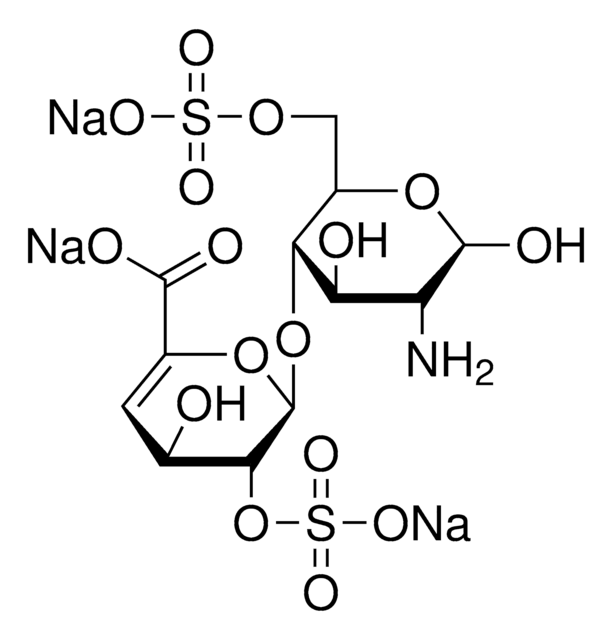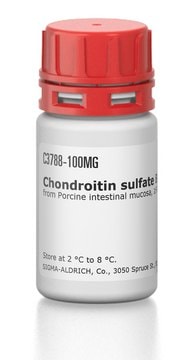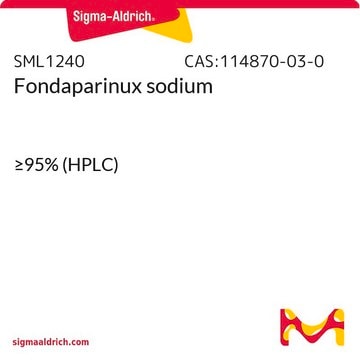H9267
Heparin disaccharide I-S sodium salt
sulfated heparin fragment
Synonym(s):
α-ΔUA-2S-[1→4]-GlcNS-6S
Sign Into View Organizational & Contract Pricing
All Photos(1)
About This Item
Linear Formula:
C12H15NO19S3Na4
CAS Number:
Molecular Weight:
665.40
MDL number:
UNSPSC Code:
12352201
PubChem Substance ID:
NACRES:
NA.25
Recommended Products
Assay
≥98%
form
powder
technique(s)
HPLC: suitable
storage temp.
−20°C
SMILES string
[Na].OC(COS(O)(=O)=O)C(OC1OC(=CC(O)C1OS(O)(=O)=O)C(O)=O)C(O)C(NS(O)(=O)=O)C=O
InChI
1S/C12H19NO19S3.Na.H/c14-2-4(13-33(20,21)22)8(17)9(6(16)3-29-34(23,24)25)31-12-10(32-35(26,27)28)5(15)1-7(30-12)11(18)19;;/h1-2,4-6,8-10,12-13,15-17H,3H2,(H,18,19)(H,20,21,22)(H,23,24,25)(H,26,27,28);;
InChI key
QNESCZPGLNWDJH-UHFFFAOYSA-N
Biochem/physiol Actions
Products of the digestion of heparin and heparan sulfate by various heparinases
Other Notes
In the following listings, ΔUA = 4-deoxy-L-threo-hex-4-enopyranosyluronic acid; GlcN = D-glucosamine; Ac = Acetyl; NS, 2S, 6S, = N-sulfo, 2-sulfate and 6-sulfate respectively.
To gain a comprehensive understanding of our extensive range of Disaccharides for your research, we encourage you to visit our Carbohydrates Category page.
Preparation Note
Produced by the action of heparinase I and II
Storage Class Code
11 - Combustible Solids
WGK
WGK 3
Flash Point(F)
Not applicable
Flash Point(C)
Not applicable
Personal Protective Equipment
dust mask type N95 (US), Eyeshields, Gloves
Choose from one of the most recent versions:
Already Own This Product?
Find documentation for the products that you have recently purchased in the Document Library.
Customers Also Viewed
Yi Xue et al.
The Journal of biological chemistry, 286(34), 29748-29757 (2011-07-01)
Missense mutations in the amyloid precursor protein (APP) gene can cause familial Alzheimer disease. It is thought that APP and APP-like proteins (APLPs) may play a role in adhesion and signal transduction because their ectodomains interact with components of the
Julia P Steringer et al.
eLife, 6 (2017-07-20)
FGF2 is secreted from cells by an unconventional secretory pathway. This process is mediated by direct translocation across the plasma membrane. Here, we define the minimal molecular machinery required for FGF2 membrane translocation in a fully reconstituted inside-out vesicle system.
Hector Moreno et al.
PLoS neglected tropical diseases, 14(12), e0009004-e0009004 (2020-12-29)
A detailed understanding of the mechanisms underlying the capacity of a virus to break the species barrier is crucial for pathogen surveillance and control. New World (NW) mammarenaviruses constitute a diverse group of rodent-borne pathogens that includes several causative agents
Our team of scientists has experience in all areas of research including Life Science, Material Science, Chemical Synthesis, Chromatography, Analytical and many others.
Contact Technical Service









